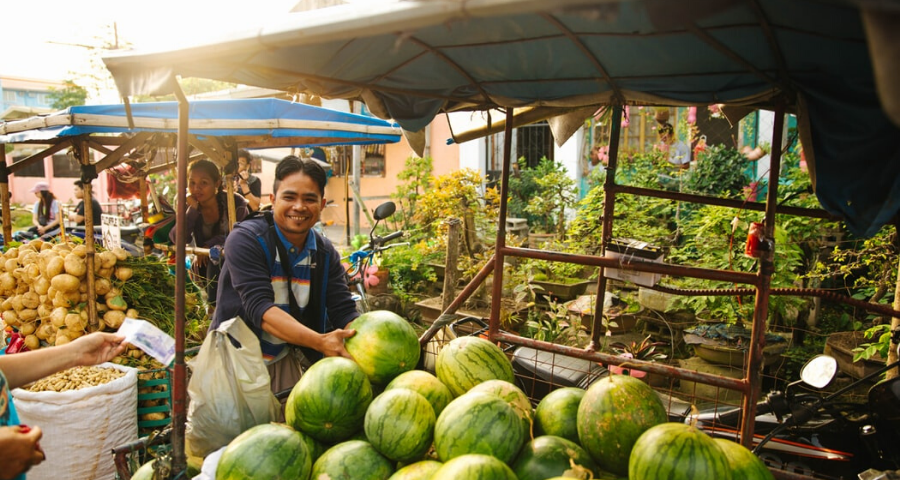-- Jessica Fanzo
In the COVID-19 pandemic, it is incredible what has been done that seemed unthinkable in “normal” times: bundles of cash have been found by state coffers to support businesses and workers; science, often held in scepticism, has been acted upon as a saving grace; and, after years of division, people are coming together, showing what seems like unprecedented levels of selflessness in providing care for those in need.
Let’s look back for a minute at what we saw as “normal” times. It’s been “normal” for years that food environments all around the world, in wealthy nations and poor ones, in urban slums and small rural settlements, place unhealthy foods - foods that do little to nourish us – in the spotlight. The world is literally flooded with junk food. It’s no coincidence that an estimated 2 billion adults globally are affected by overweight and obesity, and that poor diets are the largest cause of ill-health and premature death. This includes non-communicable conditions like heart problems, high blood pressure and diabetes, all of which are profoundly linked with the foods we eat.
It’s also “normal” for around 2.5 million children under 5 to die from undernutrition each year. That’s well over 6,000 children per day. Yes, that’s every day. All of which means they are not getting enough nutritious foods, and the foods they do eat often aren’t able to do their job because of infection and unclean water.
And for the past 20 years, it has been “normal” for millions of children (currently 144 million) to be “stunted” because while they may have enough calories (from staples and/or junk food), they are not getting the nutrients they need to grow properly, leading to what can be permanent damage to their health and livelihoods. A range of different inequalities are key underlying causes of these forms of malnutrition.
So what does this “normal” situation mean now the COVID-19 pandemic is upon us? It means, quite simply, that billions of people around the world have less resilience to fight the virus. While there is plenty of uncertainty about the nature of this disease, the WHO has made it clear that people with “underlying conditions,” like high blood pressure, heart problems or diabetes, are much more likely to develop a serious illness or die. The US Centers for Disease Control and Britain’s public health agency also state that a Body Mass Index over 40 increases vulnerability. This is because these conditions affect the body’s ability to fight the lung infections that lead to pneumonia. Older people are currently also more likely to be affected because immune systems weaken with age. The unknown is around undernourished children: we already know in general that they are more vulnerable to infectious pathogens, and more likely to die from complications with pneumonia. Although it far from certain, COVID-19 could start to kill undernourished kids once it reaches the places where most of them live: lower income countries. That’s a scary thought.

These problems that worsen the effects of COVID-19 have nothing to do with the causes of COVID-19. Nothing. Rather, they are to do with what we as a society — and what politicians, decision-makers, businesses and consumers — have been willing to accept as “normal” for decades. A normality where taking comprehensive action to create healthy food environments and addressing inequality – whether for people who simply don’t have enough foods, lack sufficient nutritious foods, or have too much of the wrong kind of foods – is seen as a “nice to” rather than “need to.” Or even worse, too economically or politically costly to bother with. This “normal” has meant that we as a society have a far lower resilience to this crisis.
This is not about rapping individuals over the knuckles for not eating better. Rather, it’s about recognising that COVID-19 shows that as a society we need to value the role of eating well far more than we do. The depth and breadth of reactions to the pandemic demonstrate that the actions we know we need to take are in fact doable.
Eating has multiple functions. The primary one is survival. Without eating, we die. It’s this basic function that has doubtless driven people in many countries to ‘panic’ around ensuring they have enough food in their homes. It’s this reason why we all should be worried about what COVID-19 means for food insecurity nand hunger. It’s this reason why so much past policy and practice has been about making sure the world has enough food, whatever it is, nourishing or otherwise.

But food has another primary function: ensuring healthy growth and development and, as such, human resilience. This is a function that policy and practice have undervalued in “normal” times yet is now proving so important in our ability to stay strong in the face of COVID-19.
Food has another function, too: it supports a system of billions of people who work growing, producing, picking, packing, transporting, distributing, processing manufacturing and selling food, a system of enormous economic importance (and which also has huge impacts on environmental sustainability). COVID-19 has shown just how important the resilience of this “food system” is and how important it is as an economic sector. Equally, it illustrates how short-term economic thinking in the food system is no excuse for crowding out the importance of human health.
Everybody hopes that the world will recover from COVID-19. But let’s not go back to “normal.” This normal is just too flawed. Instead, let’s press the reset button and create a new normal whereby eating well becomes the norm. As part of the recovery, let’s do everything we can to open the floodgates to nutritious foods – taking unhealthy foods and their relentless promotion out of the spotlight — and support the resilience this pandemic has shown we need more than ever: the health and wellbeing of all.
Corinna Hawkes is the Director of the Centre for Food Policy, Vice Chair of the London Child Obesity Taskforce and champion of effective food policy. She is a regular advisor to governments, international agencies and NGOs, she has worked with international agencies, governments, NGOs, think tanks and universities. Her work is concerned with all forms of diet-related ill-health, including obesity, malnutrition and diet-related non-communicable diseases, with a current focus on obesity prevention. She is also a Distinguished Fellow at The George Institute for Global Health. For more information on Corinna, see her full profile.

